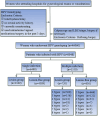Multiple high-risk human papillomavirus infections exacerbate cervical lesion risk: epidemiological evidence from suining, Sichuan
- PMID: 40764564
- PMCID: PMC12326610
- DOI: 10.1186/s12985-025-02904-6
Multiple high-risk human papillomavirus infections exacerbate cervical lesion risk: epidemiological evidence from suining, Sichuan
Abstract
Background: Studies on the pathogenicity of single and multiple human papillomavirus (HPV) infections have reported inconsistent results. Moreover, no data on HPV epidemiology in the Suining region of China have been published.
Methods: Cervical samples were collected from women undergoing gynecological examinations at the Suining Central Hospital. Fluorescent polymerase chain reaction (PCR) was used for HPV genotyping, and cytological and pathological examinations were performed to analyze the correlation between the infection patterns of high-risk HPV types (single vs. multiple infections) and cervical lesions.
Results: The most prevalent high-risk HPV types were HPV52, 58, 16, 53, and 51. The proportion of disease cases (cervical intraepithelial neoplasia or cervical cancer) in multiple infection groups (720/1,550) was significantly higher than that in single infection groups (2,109/6,498) (relative risk = 1.43, 95% confidence interval = 1.34-1.53, p < 0.001). A positive correlation was observed between the number of HPV infections and the proportion of disease cases (r = 0.839, p = 0.009).
Conclusion: Multiple HPV infections were significantly associated with more severe cervical lesions, and a higher infection multiplicity correlated with an increased pathogenic risk. Our findings support that multiple HPV infections significantly elevate cervical lesion risk, providing a basis for referring such patients to further examination.
Keywords: CIN; Cervical cancer; Human papillomavirus; Multiple infections; Pathogenicity.
© 2025. The Author(s).
Conflict of interest statement
Declarations. Ethics approval and consent to participate: This project was approved by the Medical Research Ethics Committee of Suining Central Hospital (Approval No.: KYLLKS20250095). Written informed consents were obtained from all the patients or their guardians. This study was conducted in strict compliance with medical ethics norms. Consent for publication: Not applicable. Competing interests: The authors declare no competing interests.
Figures


References
-
- Bose S, Mandal R, Banerjee D, et al. Analysis of time trends of prevalence of high-risk HPV infections, high grade cervical precancer and cervical cancer disease in women from Eastern India over 20 years– Pooled analysis from three studies[J]. Cancer Epidemiol. 2025;95:102776. - PubMed

